Exhibition: A Pictorial Review, Greater New York's Silver Jubilee, May 26-June 23, 1923
A Digital Initiatives Department Exhibit, B. Davis Schwartz Memorial Library, February 14-March 20, 2011.
- Documentation of the Exhibit
- Jubilee
- Education
- NYC Fire Department
- NYC Police Department
- NYC Street Cleaning
Department of Education
The current Fire College or Academy, as it is known today, is located on Randall’s Island. Provides Education for Children Who Are Variously Defective as Well as for Those Who Are Well.Official Book of the Silver Jubilee of Greater New York, 1924
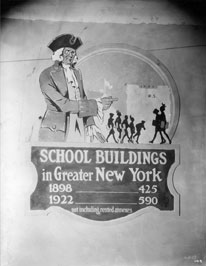
Facts and figures giving an idea of the immensity of the City and the complexity of the problems which confront its elected and appointed officials. (wrh_pr1_061.tif)
In 1924 New York City’s school system provided an education to 818,293 children from the ages of 7 to 16. Under The Compulsory Education Law all children were legally required to attend school. Even the children who held regular jobs were required to attend school for a minimum number of hours weekly. Coursework in reading, arithmetic, geography, politeness, citizenship and the history of the nation, government in practice, penmanship, spelling and composition, drawing, music, shop work, nature study, and homemaking and household arts was offered.
The Department of Education made efforts to meet the individual needs of, and provide a learning environment for, all of the City’s children. Nurses performed daily physical inspections looking for signs of contagious diseases in order to prevent contamination. Anemic and “physically sub-subnormal” children were taught in open-air rooftop classes and ungraded classes were held for scholastically and emotionally challenged children. Handicapped and physically disabled students, and blind and deaf students were instructed in separate facilities. Bedridden children were taught at home by visiting teachers. Outdoor classes were held in sanitariums on Randall’s and Ward’s Islands, and on abandoned ferry boats for children with tuberculosis.
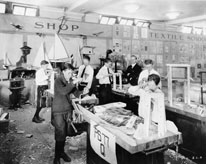
72 successive classes worked at this exhibit (wrh_pr1_228.tif)
The City’s prevocational and vocational schools offered courses relevant to the industry of the day. The schools offered concentrations in carpentry, electric wiring, machine shop, auto repair, plumbing, printing, sheet metal, sign painting and pattern making for male students. The subject specialties for female students included dressmaking, millinery, lamp-shade making, artificial flower arrangement, garment machine operating, embroidery and novelty work.
Night school was offered for adults who wanted to further their education. Courses in the English language were provided to assist foreigners in assimilation. This image depicts an evening English course. Note that 14 nationalities are represented.
The Department of Education Exhibit
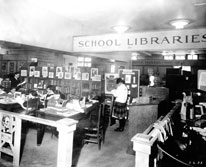
During their 'periods' school exhibitors found this is a pleasant place (wrh_pr2_020.tif)
During the Silver Jubilee, the Education exhibit was operated from 10am to 10pm, as children and teachers demonstrated current modes of teaching. The exhibition featured animated motion picture displays depicting a day’s work of various schools. The Quadrangle, a spacious area in the exhibit, was devoted to games, athletics, folk dancing, singing, health exercises, boxing, dramatics, pageantry, and other physical training exercises. The exposition was visited by 35,000 school children. It was Mayor Hylan’s intention that all of the City’s children attend.
Department of Health
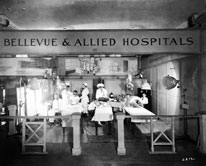
Treatment by physical agents, light, heat, electricity, massage, etc. (wrh_pr2_038.tif)
The New York City Department of Health provides care for the city’s infirm, and is responsible for the identification and control of contagious diseases. As the most important port of the country during the early part of last century, New York City also saw the importation of diseases from Europe. To prevent this as best they could, City health inspectors meticulously examined immigrants for any signs of disease, in which case the afflicted could be ordered to return to their homeland. Inspectors especially looked for highly contagious eye diseases and lice- the carrier of typhus fever.
The mass immigration that began in the 19th century, coupled with the general shift in the population from rural to urban areas overburdened the City’s infrastructure and resulted in risks to public health. Tenement housing did not provide its inhabitants adequate access to clean water and sanitation, resulting in repeated outbreaks of cholera, dysentery, TB, typhoid fever, influenza, scarlet fever, whooping cough, yellow fever, and malaria.
The discovery of bacteria in the 1880’s resulted in the adoption of hygienic practices for disease prevention. In 1892 under the direction of Dr. Hermann Biggs, the Board of Health created a new Division of Pathology, Bacteriology, and Disinfection. The Early 20th century saw the introduction of disease detection services, disease prevention measures, and vaccines. Vaccines against small-pox, typhoid fever and diphtheria were administered allowing the general death rate to fall from 20 to 12 per 1000 individuals. Mosquito extermination efforts helped curtail fatalities from malaria and yellow fever. Hygienic measures caused death rates from whooping cough and diphtheria to fall as well.
The City’s Children
At the turn of the 20th century The Bureau of Child Hygiene fought for the general welfare of children. Goals were to reduce the infant mortality rate, support health inspections of school children, and educate mothers in the care of children. The Bureau’s policy was “keeping well babies well.” The infant death rate fell from 194 per 1,000 births (19.4%) in 1898 to 71 in 1000 in 1921 (7.1%). As of 2007, the infant mortality rate in NYC was 5.4%.
The Health Department also provided veterinary service to protect animals and to promote standards of milk and meat production and distribution. At the time there was great public concern for milk safety as pathogen contamination of milk was ongoing. Following mandatory orders for pasteurization, the death rate for children under 5 fell from 67 to 25 per 1000 individuals, and for children under one year of age the death rate decreased from 205 to 75 per 1000 individuals.
Mosquito Extermination
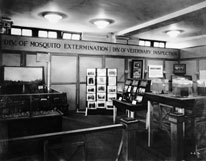
The Health Department showcased their efforts to eliminate malaria. (wrh_pr1_196.tif)
The Health Department began mosquito extermination efforts in 1901 in reaction to the 216 deaths from malarial fevers the preceding year. The New York City Board of Health ordered the elimination and treatment of bodies of stagnant water to prevent mosquito breeding on July 18, 1901. The City stepped up its efforts by creating irrigation ditches and filling swamplands throughout the five boroughs, and distributing literature outlining methods of prevention and treatment of the disease to physicians practicing within City limits. Although the number of deaths from malaria decreased to 7 in 1906 (and 5 in 1922), efforts to annihilate mosquito populations through alteration of the landscape continued through the 1940’s when malaria was all but eliminated in the region. The City began aerial spraying of insecticides in 1956, in an effort to reduce the nuisance of the large populations of the biting insects. The use of pesticides was curtailed in 1982 due to state aid, and was only reintroduced in 1999 at the onset of the West Nile Virus epidemic. Since then, annual pesticide application within the City has been mandated, and will continue in the foreseeable future. Further research is needed to identify the most effective means of mosquito eradication, and more importantly any potential environmental and human health effects of the use of these agents.
Department of Public Welfare
The Department of Public Welfare sought to provide basic human rights services and restore dignity to the people of New York City. Hospitals throughout the five boroughs fell under its jurisdiction, as did sanatoriums on Ward’s Island and Randall’s Island where children suffering from acute contagious diseases, metal illness and untreatable illnesses like epilepsy, were observed and treated. Foster care and adoption of orphaned and abandoned children were conducted through this agency as well. A Cancer Institute was established through The Department of Public Welfare at City Hospital, Welfare Island (now Roosevelt Island) to treat the afflicted poor. Treatments at the time included the use of radium, today a known carcinogenic.
Millicent Hearst (July 16, 1882 – December 5, 1974)
Millicent Willson came from humble beginnings. Raised in New York City, Millicent and her older sister Anita followed in their father’s footsteps as vaudevillian performers. After seeing Millicent in the 1897 production of The Girl from Paris at the Herald Square Theatre on Broadway, William Randolph Hearst, 34, set out to court the 16 year old actress. Millicent Willson and William Randolph Hearst were married on April 28, 1903. Millicent had five sons with Hearst before the couple separated in 1926. Millicent, who was not initially well received by Hearst’s mother, Phoebe Apperson Hearst, eventually followed suit and became a philanthropist in her own right.
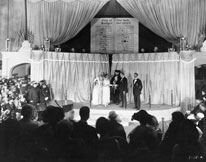
Mrs. William Randolph Hearst, Chairman, being presented with copy of Original City Charter by His Honor the Mayor. (wrh_pr1_110.tif)
Throughout her life Millicent remained active in New York society life, serving as Chairman of the Mayor’s Committee of Women. It was for this role that she was presented with a copy of the original City Charter by His Honor, Mayor Hylan during the Silver Jubilee celebration. In 1927 Hearst purchased Joan’s Castle in Sands Point to serve as Millicent’s primary residence. Millicent lived on Long Island until 1941 when the house was sold. Millicent Willson Hearst died in December 5, 1974, surviving her husband by 23 years.
Free Milk Fund for Babies
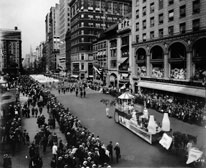
Mayor's Committee of Women float in foreground and Health Department led by Commissioner Frank J. Monaghan, M.D. (wrh_pr2_175.tif)
Like Phoebe Apperson Hearst, Millicent’s heart and devotion lent to helping unfortunate children. She became a familiar figure in social and charitable circles, often on behalf of the Hearst newspapers. She hosted fundraisers for a variety of causes including crippled children, unemployed girls, the New York Women’s Trade League, the Democratic National Committee, the Evening Journal – New York Journal Christmas Fund, and the Village Welfare of Port Washington. First Lady Eleanor Roosevelt joined Mrs. Hearst at many of these charitable events.
In 1921, Hearst founded the Free Milk Fund for Babies years before government aid was available to the needy. For decades, the fund provided New York's poverty stricken families with free milk for children. Throughout the years, Millicent fielded donations for this fund through charitable contributions from the sale of tickets for local events and movie premieres. Sports events included boxing matches held at Madison Square Garden featuring former heavyweight champion Joe Louis. In 1932, donations were collected from ticket sales at the premiere of A Bill of Divorcement starring John Barrymore and Katharine Hepburn.
Millicent declared August 14, 1939 as 'Free Milk for Babies Day'. The event was featured as part of New York World’s Fair, and Irving Berlin sung “God Bless America” to a record number of attendees. Later in 1957, Free Milk Fund for Babies, Inc. sponsored the premiere of Marilyn Monroe’s movie, The Prince and the Showgirl at Radio City Music Hall and raised a total of $35,250 from the sale of the tickets. At the dinner following the screening, Miss Monroe dined with Mrs. Hearst, who was given a bronze medal by Mayor Robert F. Wagner for her 'outstanding and distinguished contributions to the City of New York.' Arts institutions grew to support the fund as well. For example, proceeds from ticket sales at the Metropolitan Opera House were used to support the cause and in 1957 proceeds from a Life Magazine fashion spread were donated to the fund.
Phoebe Apperson Hearst (December 3, 1842 – April 13, 1919)
A school teacher before husband George Hearst became a self made millionaire, Phoebe Apperson Hearst placed great value on education. Hearst turned her attention toward civil inequalities and emphasized her efforts on creating educational opportunities for women and African Americans. Hearst recognized the importance of women’s financial independence from men and the role of education in this regard. Hearst supported this effort in the form of educational scholarships awarded to women through the University of California. Her liberal support prompted California Governor James H. Budd to appoint her as the first female regent of the University. As regent Hearst brought the issue of women’s educational equality to the national stage, at a time when the popular belief was that women’s education was a wasted effort.
Hearst also participated in the women’s suffrage movement and fostered other opportunities that could politically empower women. As it was, Susan B. Anthony was dependent on Hearst’s support, financial and otherwise, in California’s women’s suffrage campaign.
Hearst’s sights were also turned towards improving the education of America’s children. She worked to bring the German Kindergarten into California’s, and then the national, education system. Hearst was also a founding member of The National Congress of Mothers, the precursor to today’s Parent Teacher Association (PTA).
The Library of Lead, S.D.
The town of Lead, South Dakota was founded as a mining town. The prospect of gold drew immigrants from as far away as China and Europe, as well as African Americans from the south. When their efforts deemed unfruitful, many began work in the Phoebe A. Hearst’s Homestake Mine in Lead. On Christmas Day, 1894, Phoebe Apperson Hearst gifted a free public library to the town of Lead. (This was her first of many such gifts). The library provided the miners and immigrants with access to education opportunities and served as an introduction to the American middle class way of life. The small library enabled the settlers to retain cultural identity, as it offered materials in their native languages, and it also served as a gathering place. The Hearst Free Library provided a sense of permanence and served as beacon of optimism in the small mining town.
Marion Davies (January 3 1897 - September 22, 1961)
Born Marion Cecelia Douras in Brooklyn in 1897, Marion Davies is most famously known as Hearst’s long time mistress. Hearst first saw Marion on the New York stage in 1915. Hearst, 34 years her senior, courted young Marion, and by 1916 the two were seen together at parties and dinners. The couple was often in the public eye, despite the tensions and eventual separation, this caused between Hearst and his wife Millicent. Although it is speculated that the pair never married because Millicent would not grant him a divorce, they remained together until Hearst’s death in 1951.
Contrary to the popular belief that Marion Davies was ordinary, even insipid, as Orson Welles’ depiction of her in Citizen Kane would assert, Davies was charming, sincere and well respected. Although Hearst founded Cosmopolitan Productions to make her a star, Davies is considered an accomplished actress and comedienne in her own right. Despite this, she was full of humility. In response to the emergence of ‘talkies’ she states, “I couldn’t act, but the idea of silent pictures appealed to me because I couldn’t talk either.” Davies amassed a fortune from her film career and gave generously to many charitable causes, especially those helping children, in her adopted home state of California. In 1933 Davies founded the Marion Davies Children’s Clinic, which was transferred to the auspices of the UCLA School of Medicine in 1962. Davies’ charitable works did not go unrecognized, and she was bestowed the Hollywood Chamber of Commerce “Woman of the Year” award in 1958. In 1959, just two years before her death, Davies’ donated over $2 million to build a children’s clinic wing at UCLA Medical Center.
Little Old New York, one of Davies’ many film productions, was represented on the Carl Laemmle’s Productions float in the Industrial Parade held during the Silver Jubilee Celebration.
Phoebe Selected Bibliography
Nickliss, Alexandra M. 2002. Phoebe Apperson Hearst’s “Gospel of Wealth,” 1883-1901. Pacific Historical Review. 71 (4): 575-605.
Smuts, Alice. 2006. Science in the Service of Children, 1893-1935. New Haven, CT, USA: Yale University Press, 56.
Millicent Selected Bibliography
American Experience. 1997-2004. Boxing Promotion in New York City. PBS Online. http://www.pbs.org/wgbh/amex/fight/peopleevents/e_hearst.html (accessed December 6, 2010).
The Billboard. 1949. Milk Fund Benefit at Met to Mark a Flock of Firsts. The Billboard, Dec. 24.
The Daily Mirror. 1955. Famous Voices Help the Milk Fund. Daily Mirror, December 29. http://www.leroyshield.com/images/1955-milkfund.jpg (accessed December 6, 2010).
Erenberg, Lewis A. 2005. Greatest Fight of Our Generation: Louis vs. Schmeling. Cary, NC, USA: Oxford University Press. http://site.ebrary.com/lib/liu/Doc?id=10091894&ppg=81
Film Trailer DB.com. n.d. A Bill of Divorcement Starring John Barrymore and Katharine Hepburn. http://www.filmtrailerdb.com/A-Bill-of-Divorcement/ (accessed December 6, 2010).
Hearst Castle. 2001-2010. Millicent Hearst. http://www.hearstcastle.org/content/millicent-hearst-1882-1974 (accessed December 6, 2010).
Life. 1957. Look, Milton, a Bevy of Fair Women. Life, June 24.
Margolick, David. 2005. Beyond Glory: Joe Louis vs. Max Schmeling, and a World on the Brink. New York: Knopf.
Nasaw, David. 2000. The Chief. Boston: Houghton Mifflin.
Pizzitola, Louis. 2002. Hearst over Hollywood: Power, Passion and Propaganda in the Movies. New York : Columbia University Press.
Schubertiade Music LLC. 2007-2010. Summer 2008 Catalog, Lot 14. Berlin, Irving. (1888-1989). https://www.schubertiademusic.com/details/multiple_catalogs:yes/desc:Berlin,+Irving.+(1888-1989) (accessed December 6, 2010).
Turner Classic Movies. 2010. The Prince and the Showgirl (1957). http://www.tcmuk.tv/movie_database_results.php?action=title&id=16099#cast (accessed December 6, 2010).
Time. Sport: Tennists on Tour. Time, January 22. http://www.time.com/time/magazine/article/0,9171,746886,00.html (accessed December 6, 2010).
Weglein, Jessica and Wendy Scheir, Jill Peterson, Susan Malsbury, Michelle Schwartz. [The New York Public Library Manuscripts and Archives Division]. June 2008. New York World’s Fair 1939 and 1940 Incorported Records 1935-1945. MssCol 2233.
www.michelle.koenig-schwartz.com/media/nywf39fa.pdf
(accessed December 6, 2010).
Selected bibliography for Dept of Ed, Health
CDC (Center for Disease Control) MMWR Weekly July 30, 1999 / 48(29);621-629 Achievements in Public Health, 1900-1999: Control of Infectious Diseases http://www.cdc.gov/mmwr/preview/mmwrhtml/mm4829a1.htm Imperato, Pascal James. 1983.
The Early History of the New York City Department of Health. The Administration of a Public Health Agency: A Case Study of the New York City Department of Health. New York: Human Sciences Press.
Miller, James R. The Control of Mosquito-Borne Diseases in New York City. Journal of Urban Health: Bulletin of the New York Academy of Medicine. Vol. 78, No. 2, June 2001
New York (N.Y.), and Rodman Wanamaker. 1923. Official book of the silver jubilee of Greater New York, May twenty-sixth to June twenty-third, nineteen hundred and twenty-three. Under the auspices of Mayor's committee on celebration of the twenty-fifth anniversary of the greater city of New York. New York: M.B. Brown Print. and binding Co.
The New York City Department of Health and Mental Hygiene. 2005. Protecting Public Health in New York City: 200 Years of Leadership 1805-2005 http://www.nyc.gov/html/doh/html/bicentennial/bicentennial-booklet.shtml
The New York Times. 1923. Hylan Plays Role of Jubilee Guide: Finds 2 Children Gazing Wistfully at Exposition Entrance and Escorts Them Inside. New York Times (1923-Current file), June 1, http://www.proquest.com/ (accessed January 7, 2011).
Marion Davies
UCLA Department of Pediatrics. David Geffen School of Medicine at UCLA Retrieved January 24, 2011 from http://www.mattel.medsch.ucla.edu/
Ex-Star Marion Davies. Los Angeles Times; Sept. 23, 1961; ProQuest Historical Newspapers Los Angeles Times (1881-1987)
In Their Day, They Were Stars; Marion Davies and her beach house embodied Hollywood’s Golden Age. Decades later, the actress and the site are back in the limelight. Martha Groves. Los Angeles Times. Los Angeles, Calif.: Sept. 29, 2006. P. A1
